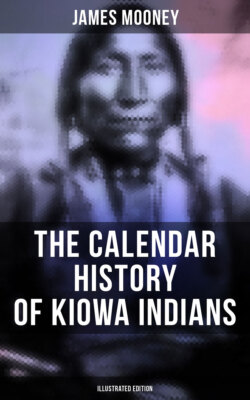Читать книгу The Calendar History of Kiowa Indians (Illustrated Edition) - James Mooney - Страница 59
На сайте Литреса книга снята с продажи.
Further Insolence of the Kiowa—Raids into Texas
ОглавлениеTable of Contents
Although they had been compelled to settle on a reservation, the Kiowa continued their raids into Texas, destroying property, killing white people, and carrying away captives. On one occasion they even attacked the agency at Fort Sill, killed and wounded several men, stampeded the agency cattle and the quartermaster's mules, and defiantly challenged the soldiers to come out and fight. Civil and military officials alike agree that there was not the slightest excuse for these outrages, to which they were encouraged by the Kwáhadi Comanche, who had never yet come in from the Staked plain and who never ceased to ridicule those Indians who had submitted. To put an end to this state of affairs, the Commissioner in 1870 recommended the establishment of a line of posts along the southern boundary of the reservation, and that the Kiowa and Comanche should all be placed under military control until they had learned to behave properly (Report, 27).
Affairs went on from bad to worse. In 1871 a large raiding party killed seven men in Texas, torturing one over a fire, and capturing a number of mules. The leaders had the hardihood to boast of their deed in the presence of the agent and General Sherman, who promptly arrested the three most prominent, Set-t'aiñte, Setängya, and Ä´do-eétte or "Big-tree." Setängya (Satank) resisted and was killed. The other two were sent to Texas for trial and punishment (see the calendar).
In 1872 another Commissioner declared that the point had been reached where forbearance had ceased to be a virtue, and again recommended that the three tribes be turned over to the military for punishment. He states that a wholesome example is absolutely necessary to command obedience, asserting that "so long as four-fifths of these tribes take turns at raiding into Texas, openly and boastfully bringing back scalps and spoils to their reservation, efforts to inspire very high ideas of social and industrial life among the communities of which the raiders form so large a part will presumably result in failure." At the same time their agent reports that, although they had come regularly for their rations during the preceding winter and spring, giving repeated assurance of amity and peace, yet so soon as their horses were in condition in summer the Kiowa had gone on the warpath, taking with them a large number of the Comanche and Apache, and within a few months had stolen hundreds of horses and mules, carried off several captive women and children, and killed over twenty persons in Texas, besides others in New Mexico and elsewhere. By withholding rations for three months, he had compelled them to bring in two captives without ransom, and states that he would continue to withhold supplies from them until the other was surrendered. He declared, finally, that the Kiowa and some bands of the Comanche were beyond control by him (Report, 28). The calendar for this year (q. v.) also takes note of these raids.
BUREAU OF AMERICAN ETHNOLOGY—SEVENTEENTH ANNUAL REPORT PL. LVIII
PHOTOS BY JACKSON, 1872.
GUI-PÄGO OR LONE-WOLF, PRINCIPAL CHIEF, 1866—1874.
Photo by Soule, about 1870.
Fig. 46—Set-ängya (Satank) or Sitting-bear.
